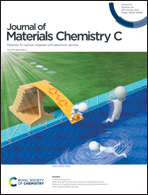Mixed dimensional 0D/3D perovskite heterostructure for efficient green light-emitting diodes†
Abstract
Metal halide perovskites are emerging materials for next-generation optoelectronic devices, of which the all-inorganic CsPbBr3 perovskite has attracted increasing attention due to its outstanding stability and excellent photoelectric characteristics compared with organic–inorganic counterparts. However, the electroluminescence (EL) efficiencies of inorganic CsPbBr3 perovskite light-emitting diodes (PeLEDs) are unsatisfactory because of high trap densities, which lead to non-radiative recombination loss. Herein, by introducing potassium bromide (KBr), we successfully prepare zero-dimensional/three-dimensional (0D/3D) Cs4−xKxPbBr6/CsPbBr3 heterostructure perovskite films with suppressed trap density and improved photoluminescence quantum yield (PLQY). The deep energy level of 0D Cs4−xKxPbBr6 phase is confirmed using DFT calculation. Moreover, the formation of the unique heterostructure inhibits the free charge diffusion at the grain boundary from suffering trapping and recombination, which facilitates efficient radiative recombination in the 3D CsPbBr3 phase. Therefore, the optimized green PeLEDs show a high external quantum efficiency (EQE) of 12.8%, which is a six-fold improvement over the pristine one (2.1%), and a maximum brightness of 39 400 cd m−2. Our work provides a rational charge carrier confinement strategy for developing high-performance PeLEDs and can be broadened to other potential perovskite materials, not restricted to the CsPbBr3-based perovskite films.



 Please wait while we load your content...
Please wait while we load your content...